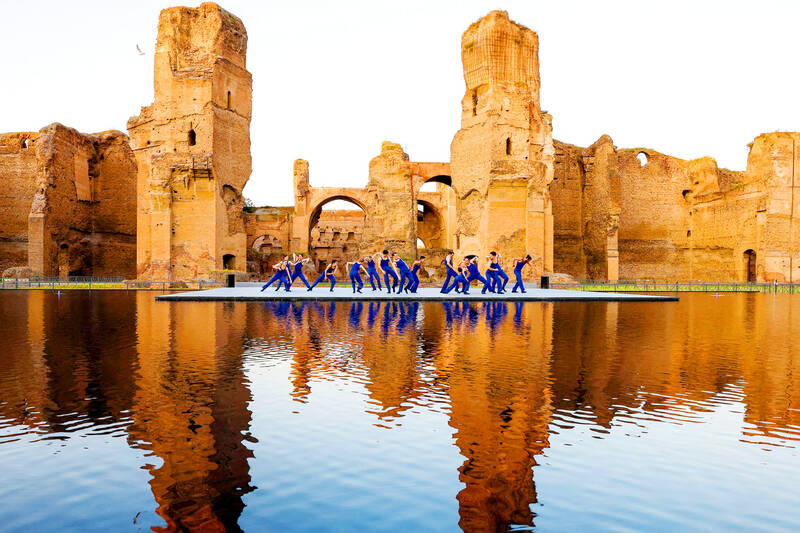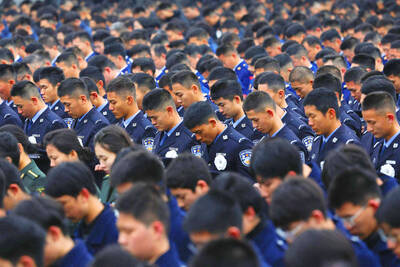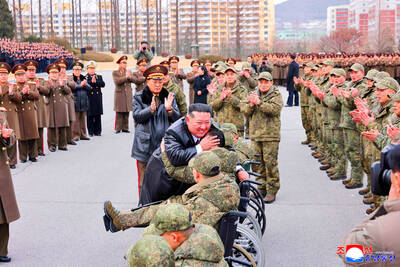The return of water to Rome’s ancient Baths of Caracalla after more than 1,000 years was on Friday greeted by ballet dancers performing on a platform over a newly installed pool.
One of the largest thermal complexes ever built, the baths were begun by Emperor Septimius Severus in 212 AD and completed four years later by his successor Caracalla. The ruins are now a popular tourist destination and host concerts and theater.
This month local authorities unveiled a project to re-introduce water to the site, installing a large, shallow pool which reflects the towering walls of the ancient buildings.

Photo: Reuters
The pool, dubbed the Specchio, or mirror in Italian, is a 42m by 32m rectangular structure that is 10cm deep, designed by architects Hannes Peer and Paolo Bornello.
It is meant to evoke the so-called Natatio, the largest of the several pools in ancient Roman baths, usually found at the center.
“Water, an element that has been absent for more than 1,000 years, returns in a decisive yet respectful way to the ruins,” Mirella Serlorenzi, the site’s director, said.
The installation, which is fitted with submerged water jets and lighting effects, is part of a broader project by Rome’s cultural authorities to make the city’s ancient sites more similar to how they were originally conceived.

China yesterday held a low-key memorial ceremony for the 1937 Nanjing Massacre, with Chinese President Xi Jinping (習近平) not attending, despite a diplomatic crisis between Beijing and Tokyo over Taiwan. Beijing has raged at Tokyo since Japanese Prime Minister Sanae Takaichi last month said that a hypothetical Chinese attack on Taiwan could trigger a military response from Japan. China and Japan have long sparred over their painful history. China consistently reminds its people of the 1937 Nanjing Massacre, in which it says Japanese troops killed 300,000 people in what was then its capital. A post-World War II Allied tribunal put the death toll

‘NO AMNESTY’: Tens of thousands of people joined the rally against a bill that would slash the former president’s prison term; President Lula has said he would veto the bill Tens of thousands of Brazilians on Sunday demonstrated against a bill that advanced in Congress this week that would reduce the time former president Jair Bolsonaro spends behind bars following his sentence of more than 27 years for attempting a coup. Protests took place in the capital, Brasilia, and in other major cities across the nation, including Sao Paulo, Florianopolis, Salvador and Recife. On Copacabana’s boardwalk in Rio de Janeiro, crowds composed of left-wing voters chanted “No amnesty” and “Out with Hugo Motta,” a reference to the speaker of the lower house, which approved the bill on Wednesday last week. It is

FALLEN: The nine soldiers who were killed while carrying out combat and engineering tasks in Russia were given the title of Hero of the Democratic People’s Republic of Korea North Korean leader Kim Jong-un attended a welcoming ceremony for an army engineering unit that had returned home after carrying out duties in Russia, North Korean state media KCNA reported on Saturday. In a speech carried by KCNA, Kim praised officers and soldiers of the 528th Regiment of Engineers of the Korean People’s Army (KPA) for “heroic” conduct and “mass heroism” in fulfilling orders issued by the ruling Workers’ Party of Korea during a 120-day overseas deployment. Video footage released by North Korea showed uniformed soldiers disembarking from an aircraft, Kim hugging a soldier seated in a wheelchair, and soldiers and officials

Cozy knits, sparkly bobbles and Santa hats were all the canine rage on Sunday, as hundreds of sausage dogs and their owners converged on central London for an annual parade and get-together. The dachshunds’ gathering in London’s Hyde Park came after a previous “Sausage Walk” planned for Halloween had to be postponed, because it had become so popular organizers needed to apply for an events licence. “It was going to be too much fun so they canceled it,” laughed Nicky Bailey, the owner of three sausage dogs: Una and her two 19-week-old puppies Ember and Finnegan, wearing matching red coats and silver